- Home
- Ann M. Martin
Stacey and the Mystery at the Mall Page 3
Stacey and the Mystery at the Mall Read online
Page 3
“Mine!” said Sandy from behind me. He was frowning, and he held out his hand for the horse.
“Unfortunately, Sandy thinks everything in the store belongs to him,” said April, scooping him up. She hugged Sandy and kissed the top of his head. “Makes it difficult to sell things sometimes.”
“Two-year-olds can be that way,” I said. “Mine is their favorite word, isn’t it? I baby-sit a lot, so I’m used to it.” I told April a little about the BSC.
“What a great idea,” said April. “I could sure use a BSC in my neighborhood!”
“So,” I said, eager to start working, “what would you like me to do today?”
“Let’s see,” said April. “I’ve been thinking about changing the display tables. Why don’t you put away the farm and set up this dollhouse in its place?” She showed me a carton containing a snap-together dollhouse, and a few other boxes that held furniture and brightly colored plastic people. “The farm stuff goes in these,” she said, handing me some empty boxes. “After you’ve done that, you can take your break, and then maybe I can give you another lesson on the cash register. Does that sound okay?”
“It sounds great,” I said. I got down on my knees and started to take the barn apart. I didn’t really feel I would need a break that afternoon, but all the Project Work jobs followed the same schedule. Mr. Withum had told us about it that day in class. “You’ll work for two hours every afternoon,” he had said, “with a fifteen-minute break at some point. Please be sure you’re on time, and don’t abuse your break privileges.” My friends and I had already planned to visit each other on our breaks.
I was busy separating the animals into various piles when April returned. “By the way,” she said. “I forgot to mention one important thing. While you’re in the store, I’d like you to keep an eye out for shoplifters. Merchandise walks out of this store all the time, especially the little things up front near the cash register.”
“That’s awful,” I said.
April shrugged. “It’s a fact of life,” she said. “All stores have to deal with it. Lately, though, it seems as if it’s happening more than ever.” She looked over at Sandy, who was tearing into a pile of puzzles. “Oh, no, Sandy!” she said, running to stop him.
“He can help me,” I said, “if you want to keep him busy, that is.”
“That would be great,” said April. “Sandy, want to help Stacey with the farm?” she asked.
“Hoss!” said Sandy, pointing at the horse I held in my right hand.
“Good!” I said. “Can you find the right pile for the horsie?” I handed it to him. Sandy and I spent a peaceful half hour packing up the farm animals. Then, just as I was pulling the dollhouse pieces out of their boxes, Claudia turned up.
“You look like you’re having a good time,” she said. “What a great job. You get to play all day!”
“How’s your job?” I asked.
“It’s the coolest,” said Claud. “You wouldn’t believe how much I’ve learned in one day! They have these amazing new acrylic paints over there. I’ve already decided to save up for them.”
“You’re going to become their best customer,” I said, smiling.
“I know,” she admitted. “But I don’t mind spending my money there. The owners are really nice people.” She frowned. “I can’t believe anybody would steal stuff from them, but they said they have a problem with shoplifting. It’s been much worse lately.”
“April said the same thing about Toy Town,” I said. “It’s a shame.”
Claudia picked up the mother doll from the pile on the table. “I wish I’d had a dollhouse like this when I was little,” she said, checking out the mother’s tiny plastic shoes.
“Mine,” said Sandy.
“Oh,” I said. “I forgot to introduce you to Sandy. He’s April’s son.”
“Nice to meet you,” said Claudia, bending down to say hi to him. She handed him the doll. “And now I’ve got to run. My break’s almost up.”
“See you on the bus!” I said.
I spent the next half hour putting together the dollhouse. Sandy helped, and we had a great time. Just as I was setting the dollhouse father in the kitchen and the mother in the garage (this was a liberated doll family, I had decided), April came over to take a look. “Wonderful,” she said. “Why don’t you go ahead and take your break?” She picked up Sandy. “And you, young man, can help me at the cash register.”
I left the store and decided to head down the hall to see Mal at the bookstore. I found her in the children’s section, of course. She was arranging books on the shelves. “Stacey!” she said, when she saw me. “Isn’t this the coolest store? I love it here. Look at this book that just came in. Aren’t the illustrations fantastic?”
Mal’s face was flushed. I was glad to see her so happy. A bookstore really is the perfect place for her. I looked at the book she handed me, which was an updated version of Little Red Riding Hood. “Cool,” I said. “I can see you making a book like this someday.”
“That would be awesome,” said Mal. “Can you imagine going to a bookstore and seeing books with your name on them?”
A woman walked by just then, and smiled at Mal. “Whoa!” said Mal. “That’s Ms. Munro, my manager. She’s really nice, but she probably wants me to get back to work.” Mal watched as the woman moved away. “She walks around the store like that all day, watching for shoplifters,” she added. “Apparently, it’s kind of a problem here. And Jessi stopped by before and told me that her bosses at Cinema World are upset because people are always trying to sneak into the movies.”
I handed the book back to Mal. “It’s awful,” I said. “Until I worked here, I didn’t know there was so much of that kind of thing going on at the mall. But it happens at Claud’s store, and at Toy Town, too.” We looked at each other and shrugged. “Well, see you later!” I said. “I’ll let you get back to work. I’m going to head upstairs to see Mary Anne.”
At Critters, Mary Anne was working on a window display. She held up a dog toy shaped like a hamburger. “Don’t you think this would look good near that other one, the one that looks like a hot dog?” she asked. She squeezed the toy and it squeaked. We giggled.
“Hey, Mary Anne,” I said, suddenly curious. “Do people ever steal stuff like that from here?”
“Funny you should ask,” she said. “That was one of the first things the store owner told me to look out for. I didn’t really believe him, but I guess it’s true. Personally, I can’t imagine a dog- or cat-lover stealing anything, but according to him, it happens all the time.”
I shook my head, frowning.
“Not only that,” Mary Anne added, “but Logan stopped by here on his break, and guess what he told me? There’s even shoplifting going on at the food court.”
I raised my eyebrows. Mary Anne nodded. “It’s true,” she said. “People walk off with pretzels and stuff while the workers are busy getting the rest of their orders.”
“Speaking of busy,” I said, glancing at my watch, “I’d better get back to Toy Town. My break’s just about over.” I said good-bye to Mary Anne and headed for the escalator.
“Hey, Stacey!” I turned to see Kristy walking toward me. She was wearing a black baseball cap that said “Washington Mall Security” in gold script, and a walkie-talkie hung from her belt.
“Hey, Officer Thomas,” I replied. “Enjoying your job?” We stepped onto the escalator together.
She grinned. “It’s great.”
“I hear there’s a lot of shoplifting going on around here,” I said.
“That’s right. But we’re on the case.” Her walkie-talkie made a crackling noise, and she grabbed it just as we reached the bottom of the escalator.
“I have to run,” I said. “I’m going to be late.”
Kristy nodded as she put the walkie-talkie to her ear. “See you on the bus,” she said.
Back at Toy Town, April was busy at the cash register, and a line of people was waiting to be helped. “What ca
n I do?” I asked.
April nodded toward the back of the store, where a boy was playing noisily near the train set. “Encourage him to use the display toys,” she said. “I try to leave enough out, but the kids always go for the new stuff.”
I walked back and discovered that the boy, who looked about seven, was tearing into a new package of LEGOs. Another package, already opened, was at his feet. “How about leaving those on the shelf?” I said. “We can check out this train set instead.”
He just stared at me.
I looked around for his mother. “Where’s your mom?” I asked. “Or are you here with your dad? Or a baby-sitter?”
“My mom’s shopping,” the boy answered. “She said she’d be back soon.”
I couldn’t believe it. This boy’s mother had left him here, all by himself! I spent a few minutes helping him clean up the LEGOs, and by the time we finished, his mother had turned up. “Have a good time, Jason?” she asked. She turned to me. “I always leave him here while I shop. He’s happier, and I can be a lot more productive.”
I watched her leave, shaking my head. April saw me and smiled. “I know, it’s awful,” she said. “But it happens all the time, and what can I do? It’s not like there’s any better place to leave a kid while you shop.” She shrugged. I was amazed she took it so well. The idea seemed crazy to me.
On the way home that afternoon, my friends and I talked about our first day on the job. I told my friends about Jason’s mom leaving him at the store, and to my surprise they were not shocked. Mal had heard about the same thing happening at the bookstore, and Logan had seen kids left at the food court.
I’ve always liked Washington Mall, and I loved my new job, but I was beginning to wonder about a few things. Shoplifting, kids left alone. Working in the real world was an eye-opener.
Mal’s job at the BookCenter was going well. Her manager was friendly and helpful, the work wasn’t too hard, and Mal adored being surrounded by books. She especially loved the children’s section and Ms. Munro let her work there most afternoons. The BookCenter has the best selection of children’s books Mal had ever seen in a bookstore. On top of that, the area is set up to make kids feel at home. There are pillows to lounge on, small, child-sized chairs, and stuffed animals scattered around. Kids who come into the store are encouraged to check out the books on the shelves, and sit down for a closer look at the ones that interest them.
Plus, the children’s section has a small “stage” area for puppet shows, storytellers, and story hour.
“We haven’t had a story hour in about a month,” Ms. Munro had told Mal the week before. “One of our staff members took some time off because she had a baby. But I have a feeling you’d be great at it.”
And that was how Mal was talked into story hour. It didn’t take much persuading, because Mal thought it sounded like fun. But when she arrived at the store that afternoon and saw the big sign outside advertising story hour — with her name, Mallory Pike, in bold red letters — well, that’s when she started to feel nervous. Maybe, she thought, this was a bigger deal than she had realized.
She headed for the children’s section and found Ms. Munro there, setting up the stage. There was a chair for Mal, with a pile of books next to it. “I hope you don’t mind, but I picked out a few books for your first time,” said Ms. Munro. “The kids always like these, and sometimes it’s best to start with books that are tried and true. Next time, you can pick out your own.”
Mal sat down and looked over the books. One of them was Stone Soup, which had been a favorite of her brother Nicky’s. Then there was The Cat in the Hat, which her sisters Claire and Margo absolutely loved. And the third one was a huge, oversized edition of Tikki Tikki Tembo, a book Mal herself had always liked. “These look great,” she told Ms. Munro.
“I wish I had more of the really big books,” said Ms. Munro, gesturing toward Tikki Tikki Tembo. “The kids adore them. Anyway, why don’t you take some time to read through those?” She checked her watch. “You have fifteen minutes or so.”
But about five minutes later, the kids began to arrive, and before Mal knew it she had what looked to her like a huge audience. “There were probably only fifteen kids there,” she told me later, “but from up on the stage it looked like there were fifteen hundred.”
The kids, who mostly ranged in age from three to five or so, seemed restless. A few parents were there, but a lot of the kids were on their own. Mal figured their parents must be using story hour as sort of a baby-sitter while they went shopping in the mall. The noise level was high as the kids settled in. A boy in the front row was poking his friend, who squealed and giggled and poked him back. Two girls were running from spot to spot, trying to find the best seats. And a baby who sat on its mother’s lap was beginning to get fussy. Mal glanced at the clock on the wall. She wasn’t supposed to start for another five minutes, but she had a feeling she might have a small riot on her hands if she waited that long.
Taking a deep breath, Mal reached for Stone Soup. “Hi,” she said, looking out at the crowd of kids. They ignored her. “Hi,” she said more loudly. This time they looked up at her. “Welcome to the BookCenter story hour!” she said, trying to sound enthusiastic and confident. “My name is Mallory, and I’m going to read you a few books today.”
“Can you read The Little Red Hen?” called a small girl with a red bow in her hair.
“Um, well, not today,” said Mal. “Maybe next week.”
“How about Barney and the Bully?” asked a boy wearing a Barney T-shirt.
Mal didn’t even know if such a book existed, so she just shook her head. “I don’t have that one, but I think you’ll like the ones I do have.” She held up Stone Soup. “This one is called Stone Soup. Do any of you know this story?”
A girl in the front row raised her hand. “My teacher read that to us last week,” she said. “It’s fun.”
“Great,” said Mal. “Let’s get started.” She opened the book and began to read.
Do you know the story of Stone Soup? There are a few different versions of it, but basically, it’s about how a group of people cooperate to make a wonderful meal, even when they think they have no food at all. They start a pot of water boiling and add some “magic” stones. Then one person adds a carrot, and another one adds a potato, and somebody else adds some cabbage. Before you know it, there’s a big pot of delicious soup. It’s a great story.
But Mal was having some trouble convincing the kids of that fact. They still seemed restless, and they weren’t paying much attention. Mal tried to put a lot of expression into her reading, and after she read each page, she held up the book so the kids could see the picture. She even tried to read with the book held up next to her, so they could see the picture as she read, but that was pretty hard.
Finally, one of the boys yelled out, “This is a dumb story. And the pictures are too little. I can’t even see what the people look like!”
Mal blushed. Her first story hour was bombing in a big way. She glanced down at the floor and saw Tikki Tikki Tembo. “Okay,” she said. “How about if we move on to the next book? This one has really big pictures.” She picked it up and showed it to them.
“Yay!” yelled a couple of kids. Mal looked around at her audience and noticed that it had grown. A couple of slightly older kids were there now, kids Mal thought she had seen in the bookstore before. One was a blonde girl who looked about six, and the other was a boy, obviously her brother (he had the same turned-up nose, Mal told me), and apparently a couple of years older. They were on their own, and they were a little dirty and scruffy, but they were behaving well. The girl looked up at Mal and smiled. “I love that book. I can say Tikki Tikki Tembo’s whole name,” she said.
“Good,” said Mal. “I hope everybody will be able to do that by the time we finish reading this.” She opened the book and tried to hold it up so everybody could see. It was a huge book, so the pictures were big enough, but it was floppy. Mal struggled to keep it upright as she began
to read.
Tikki Tikki Tembo is the story of two young brothers who live in a small mountain village in China. One of them is named Chang. He is the second-born son, and so, because it’s the custom, he has a very short name. But his older brother, the firstborn son, has a long, long name and that’s what causes the trouble. What happens first is that Chang falls into a well. His brother runs for help, and help comes quickly. But then the older brother, the firstborn son, falls into the well. And when Chang runs for help, it takes a lot longer. Why? Because every time Chang tries to tell somebody that his brother has fallen into the well, he has to start by saying his brother’s name, which is this: Tikki tikki tembo-no sa rembo-chari bari ruchi-pip peri pembo!
Kids, naturally, love that book. The name is repeated over and over, and soon they learn to chant it along with whoever is reading to them. By the middle of the story, Mal’s arms were tired from holding up the giant book and turning the pages, and her neck was stiff from looking at the book sideways, and her throat was scratchy from reading out loud — but Mal was happy. The kids were crazy about the book, and every time Mal started to say, “Tikki tikki tembo,” the kids joined in and said it along with her, shouting out the last “pip peri pembo!” so loudly that shoppers from all over the store came to see what was going on in the children’s section. Mal was a big hit.
After she finished Tikki Tikki Tembo, Mal swung right into The Cat in the Hat, which was also a crowd-pleaser. And when Mal finished that, they begged for another. “Sorry,” said Mal, who had noticed that a lot of parents were already waiting to pick up their kids. “That’s all for today, but come back next week.”

 Karen's Tea Party
Karen's Tea Party Kristy and the Snobs
Kristy and the Snobs Best Kept Secret
Best Kept Secret Karen's Kittens
Karen's Kittens Karen's Big Job
Karen's Big Job Claudia and the Genius of Elm Street
Claudia and the Genius of Elm Street The Fire at Mary Anne's House
The Fire at Mary Anne's House Science Fair
Science Fair Me and Katie (The Pest)
Me and Katie (The Pest) Karen's Plane Trip
Karen's Plane Trip Jessi's Wish
Jessi's Wish Dawn and Too Many Sitters
Dawn and Too Many Sitters Jessi and the Jewel Thieves
Jessi and the Jewel Thieves Eleven Kids, One Summer
Eleven Kids, One Summer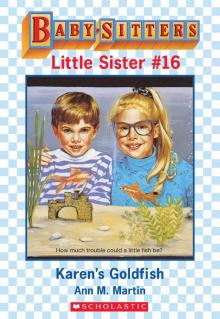 Karen's Goldfish
Karen's Goldfish Snow War
Snow War Abby and the Secret Society
Abby and the Secret Society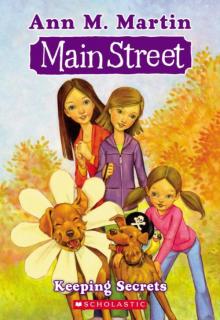 Keeping Secrets
Keeping Secrets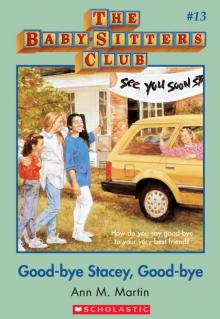 Good-Bye Stacey, Good-Bye
Good-Bye Stacey, Good-Bye Karen's Sleepover
Karen's Sleepover Claudia and the World's Cutest Baby
Claudia and the World's Cutest Baby Mary Anne Saves the Day
Mary Anne Saves the Day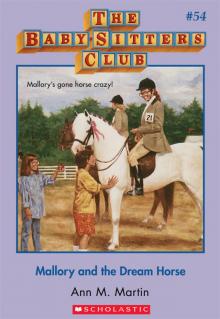 Mallory and the Dream Horse
Mallory and the Dream Horse Kristy and the Mystery Train
Kristy and the Mystery Train Dawn's Family Feud
Dawn's Family Feud Karen's Twin
Karen's Twin Little Miss Stoneybrook... And Dawn
Little Miss Stoneybrook... And Dawn Karen's Mistake
Karen's Mistake Karen's Movie Star
Karen's Movie Star Mallory and the Mystery Diary
Mallory and the Mystery Diary Karen's Monsters
Karen's Monsters Kristy + Bart = ?
Kristy + Bart = ? Karen's Dinosaur
Karen's Dinosaur Here Today
Here Today Karen's Carnival
Karen's Carnival How to Look for a Lost Dog
How to Look for a Lost Dog Stacey vs. Claudia
Stacey vs. Claudia Stacey's Ex-Boyfriend
Stacey's Ex-Boyfriend Here Come the Bridesmaids!
Here Come the Bridesmaids! Graduation Day
Graduation Day Kristy's Big News
Kristy's Big News Karen's School Surprise
Karen's School Surprise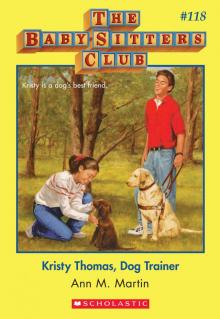 Kristy Thomas, Dog Trainer
Kristy Thomas, Dog Trainer Baby-Sitters' Christmas Chiller
Baby-Sitters' Christmas Chiller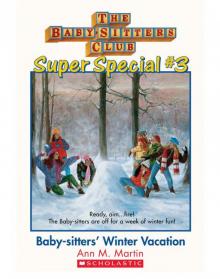 Baby-Sitters' Winter Vacation
Baby-Sitters' Winter Vacation Ten Good and Bad Things About My Life
Ten Good and Bad Things About My Life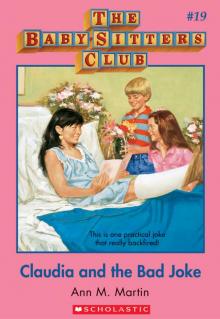 Claudia and the Bad Joke
Claudia and the Bad Joke Mary Anne's Makeover
Mary Anne's Makeover Stacey and the Fashion Victim
Stacey and the Fashion Victim Dawn Schafer, Undercover Baby-Sitter
Dawn Schafer, Undercover Baby-Sitter Karen's Tuba
Karen's Tuba Dawn's Wicked Stepsister
Dawn's Wicked Stepsister Diary Three: Dawn, Sunny, Maggie, Amalia, and Ducky
Diary Three: Dawn, Sunny, Maggie, Amalia, and Ducky Karen's Nanny
Karen's Nanny Jessi and the Awful Secret
Jessi and the Awful Secret Karen's New Year
Karen's New Year Karen's Candy
Karen's Candy Karen's President
Karen's President Mary Anne and the Great Romance
Mary Anne and the Great Romance Mary Anne + 2 Many Babies
Mary Anne + 2 Many Babies Kristy and the Copycat
Kristy and the Copycat Jessi and the Bad Baby-Sitter
Jessi and the Bad Baby-Sitter Claudia, Queen of the Seventh Grade
Claudia, Queen of the Seventh Grade Claudia and the Lighthouse Ghost
Claudia and the Lighthouse Ghost Karen's New Puppy
Karen's New Puppy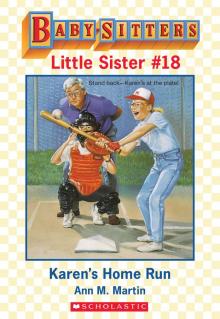 Karen's Home Run
Karen's Home Run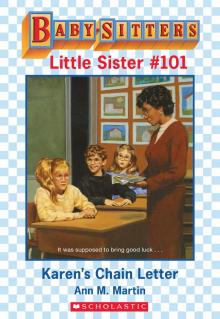 Karen's Chain Letter
Karen's Chain Letter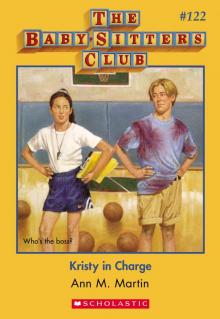 Kristy in Charge
Kristy in Charge Karen's Angel
Karen's Angel Mary Anne and Too Many Boys
Mary Anne and Too Many Boys Karen's Big Fight
Karen's Big Fight Karen's Spy Mystery
Karen's Spy Mystery Stacey's Big Crush
Stacey's Big Crush Karen's School
Karen's School Claudia and the Terrible Truth
Claudia and the Terrible Truth Karen's Cowboy
Karen's Cowboy The Summer Before
The Summer Before Beware, Dawn!
Beware, Dawn! Belle Teale
Belle Teale Claudia's Big Party
Claudia's Big Party The Secret Life of Mary Anne Spier
The Secret Life of Mary Anne Spier Karen's Book
Karen's Book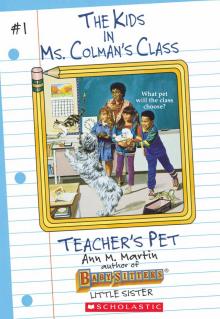 Teacher's Pet
Teacher's Pet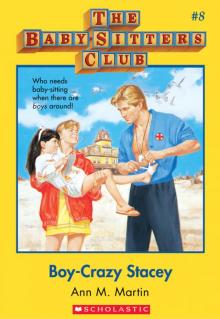 Boy-Crazy Stacey
Boy-Crazy Stacey Claudia and the Disaster Date
Claudia and the Disaster Date Author Day
Author Day Claudia and the Sad Good-Bye
Claudia and the Sad Good-Bye Kristy and the Worst Kid Ever
Kristy and the Worst Kid Ever Yours Turly, Shirley
Yours Turly, Shirley Class Play
Class Play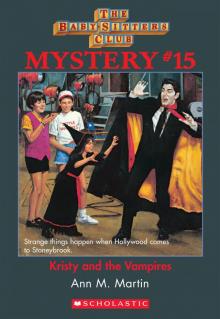 Kristy and the Vampires
Kristy and the Vampires Kristy and the Cat Burglar
Kristy and the Cat Burglar Karen's Pumpkin Patch
Karen's Pumpkin Patch Stacey and the Mystery at the Empty House
Stacey and the Mystery at the Empty House Karen's Chicken Pox
Karen's Chicken Pox Mary Anne and the Playground Fight
Mary Anne and the Playground Fight Stacey's Mistake
Stacey's Mistake Coming Apart
Coming Apart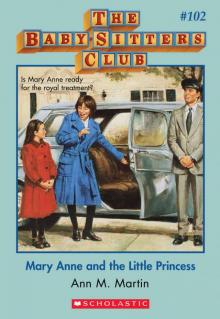 Mary Anne and the Little Princess
Mary Anne and the Little Princess Karen, Hannie and Nancy: The Three Musketeers
Karen, Hannie and Nancy: The Three Musketeers 'Tis the Season
'Tis the Season Claudia and Mean Janine
Claudia and Mean Janine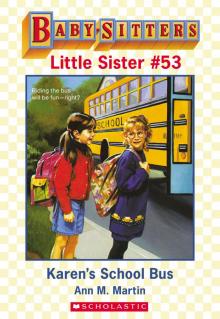 Karen's School Bus
Karen's School Bus Mary Anne's Big Breakup
Mary Anne's Big Breakup Rain Reign
Rain Reign Claudia and the Mystery at the Museum
Claudia and the Mystery at the Museum Claudia and the Great Search
Claudia and the Great Search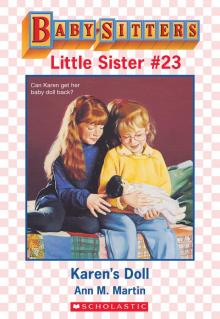 Karen's Doll
Karen's Doll Shannon's Story
Shannon's Story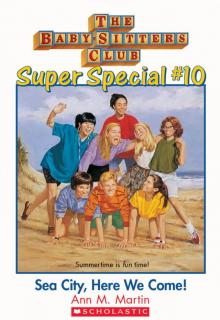 Sea City, Here We Come!
Sea City, Here We Come! Stacey and the Mystery of Stoneybrook
Stacey and the Mystery of Stoneybrook Karen's Treasure
Karen's Treasure Ten Rules for Living With My Sister
Ten Rules for Living With My Sister With You and Without You
With You and Without You Baby-Sitters' Island Adventure
Baby-Sitters' Island Adventure Karen's Fishing Trip
Karen's Fishing Trip Dawn and the Big Sleepover
Dawn and the Big Sleepover New York, New York!
New York, New York! Ten Kids, No Pets
Ten Kids, No Pets Happy Holidays, Jessi
Happy Holidays, Jessi Halloween Parade
Halloween Parade Karen's New Holiday
Karen's New Holiday Kristy Power!
Kristy Power! Karen's Wish
Karen's Wish Claudia and the Mystery in the Painting
Claudia and the Mystery in the Painting Karen's Stepmother
Karen's Stepmother Abby in Wonderland
Abby in Wonderland Karen's Snow Day
Karen's Snow Day Kristy and the Secret of Susan
Kristy and the Secret of Susan Karen's Pony Camp
Karen's Pony Camp Karen's School Trip
Karen's School Trip Mary Anne to the Rescue
Mary Anne to the Rescue Karen's Unicorn
Karen's Unicorn Abby and the Notorious Neighbor
Abby and the Notorious Neighbor Stacey and the Haunted Masquerade
Stacey and the Haunted Masquerade Claudia Gets Her Guy
Claudia Gets Her Guy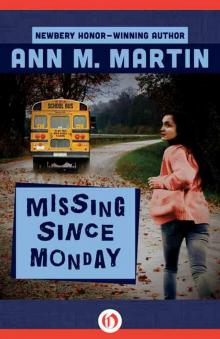 Missing Since Monday
Missing Since Monday Stacey's Choice
Stacey's Choice Stacey's Ex-Best Friend
Stacey's Ex-Best Friend Karen's New Teacher
Karen's New Teacher Karen's Accident
Karen's Accident Karen's Lucky Penny
Karen's Lucky Penny Karen's Cartwheel
Karen's Cartwheel Karen's Puppet Show
Karen's Puppet Show Spelling Bee
Spelling Bee Stacey's Problem
Stacey's Problem Stacey and the Stolen Hearts
Stacey and the Stolen Hearts Karen's Surprise
Karen's Surprise Karen's Worst Day
Karen's Worst Day The Ghost at Dawn's House
The Ghost at Dawn's House Karen's Big Sister
Karen's Big Sister Karen's Easter Parade
Karen's Easter Parade Mary Anne and the Silent Witness
Mary Anne and the Silent Witness Karen's Swim Meet
Karen's Swim Meet Mary Anne's Revenge
Mary Anne's Revenge Karen's Mystery
Karen's Mystery Stacey and the Mystery Money
Stacey and the Mystery Money Dawn and the Disappearing Dogs
Dawn and the Disappearing Dogs Karen's Christmas Tree
Karen's Christmas Tree Welcome to Camden Falls
Welcome to Camden Falls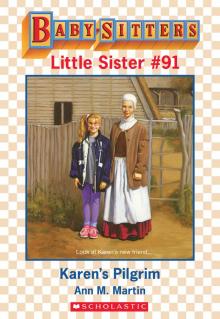 Karen's Pilgrim
Karen's Pilgrim Dawn and the Halloween Mystery
Dawn and the Halloween Mystery Mary Anne in the Middle
Mary Anne in the Middle Karen's Toys
Karen's Toys Kristy's Great Idea
Kristy's Great Idea Claudia and the Middle School Mystery
Claudia and the Middle School Mystery Karen's Big Weekend
Karen's Big Weekend Logan's Story
Logan's Story Karen's Yo-Yo
Karen's Yo-Yo Kristy's Book
Kristy's Book Mallory and the Ghost Cat
Mallory and the Ghost Cat Mary Anne and the Music
Mary Anne and the Music Karen's Tattletale
Karen's Tattletale Karen's County Fair
Karen's County Fair Karen's Mermaid
Karen's Mermaid Snowbound
Snowbound Karen's Movie
Karen's Movie Jessi and the Troublemaker
Jessi and the Troublemaker Baby-Sitters at Shadow Lake
Baby-Sitters at Shadow Lake Mallory on Strike
Mallory on Strike Jessi's Baby-Sitter
Jessi's Baby-Sitter Karen's Leprechaun
Karen's Leprechaun Claudia and the Phantom Phone Calls
Claudia and the Phantom Phone Calls Karen's Good-Bye
Karen's Good-Bye Karen's Figure Eight
Karen's Figure Eight Logan Likes Mary Anne!
Logan Likes Mary Anne! Mary Anne and the Zoo Mystery
Mary Anne and the Zoo Mystery Missy Piggle-Wiggle and the Whatever Cure
Missy Piggle-Wiggle and the Whatever Cure Dawn on the Coast
Dawn on the Coast Stacey and the Cheerleaders
Stacey and the Cheerleaders Claudia and the Clue in the Photograph
Claudia and the Clue in the Photograph Karen's New Friend
Karen's New Friend Mallory and the Trouble With Twins
Mallory and the Trouble With Twins Karen's Roller Skates
Karen's Roller Skates Abby and the Best Kid Ever
Abby and the Best Kid Ever Poor Mallory!
Poor Mallory! Karen's Witch
Karen's Witch Karen's Grandmothers
Karen's Grandmothers Slam Book
Slam Book Karen's School Picture
Karen's School Picture Karen's Reindeer
Karen's Reindeer Kristy's Big Day
Kristy's Big Day The Long Way Home
The Long Way Home Karen's Sleigh Ride
Karen's Sleigh Ride On Christmas Eve
On Christmas Eve Karen's Copycat
Karen's Copycat Karen's Ice Skates
Karen's Ice Skates Claudia and the Little Liar
Claudia and the Little Liar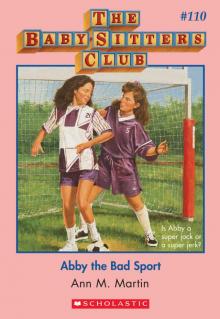 Abby the Bad Sport
Abby the Bad Sport The Baby-Sitters Club #5: Dawn and the Impossible Three
The Baby-Sitters Club #5: Dawn and the Impossible Three Abby's Book
Abby's Book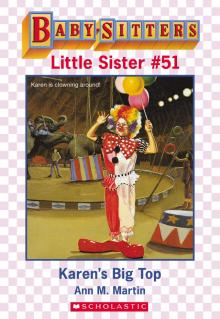 Karen's Big Top
Karen's Big Top Main Street #8: Special Delivery
Main Street #8: Special Delivery Kristy and the Kidnapper
Kristy and the Kidnapper Karen's Ski Trip
Karen's Ski Trip Karen's Hurricane
Karen's Hurricane Stacey and the Mystery at the Mall
Stacey and the Mystery at the Mall Jessi and the Superbrat
Jessi and the Superbrat Kristy and the Baby Parade
Kristy and the Baby Parade Karen's New Bike
Karen's New Bike Karen's Big City Mystery
Karen's Big City Mystery Baby-Sitters' European Vacation
Baby-Sitters' European Vacation Hello, Mallory
Hello, Mallory Dawn's Big Date
Dawn's Big Date Karen's Christmas Carol
Karen's Christmas Carol Jessi's Horrible Prank
Jessi's Horrible Prank Kristy and the Missing Fortune
Kristy and the Missing Fortune Kristy and the Haunted Mansion
Kristy and the Haunted Mansion Jessi's Big Break
Jessi's Big Break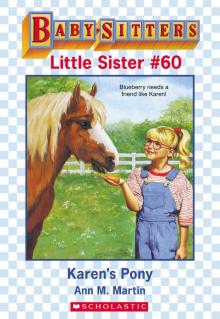 Karen's Pony
Karen's Pony Welcome Home, Mary Anne
Welcome Home, Mary Anne Stacey the Math Whiz
Stacey the Math Whiz September Surprises
September Surprises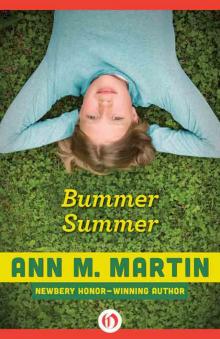 Bummer Summer
Bummer Summer Karen's Secret
Karen's Secret Abby's Twin
Abby's Twin Main Street #4: Best Friends
Main Street #4: Best Friends Karen's Big Move
Karen's Big Move Mary Anne Misses Logan
Mary Anne Misses Logan Stacey's Book
Stacey's Book Claudia and the Perfect Boy
Claudia and the Perfect Boy Holiday Time
Holiday Time Stacey's Broken Heart
Stacey's Broken Heart Karen's Field Day
Karen's Field Day Kristy's Worst Idea
Kristy's Worst Idea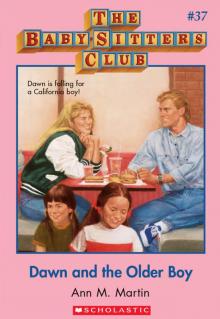 Dawn and the Older Boy
Dawn and the Older Boy Karen's Brothers
Karen's Brothers Claudia's Friend
Claudia's Friend Mary Anne and the Haunted Bookstore
Mary Anne and the Haunted Bookstore Dawn and Whitney, Friends Forever
Dawn and Whitney, Friends Forever Summer School
Summer School Karen's Birthday
Karen's Birthday Karen's Black Cat
Karen's Black Cat Stacey McGill... Matchmaker?
Stacey McGill... Matchmaker? Claudia's Book
Claudia's Book Main Street #2: Needle and Thread
Main Street #2: Needle and Thread Karen's Runaway Turkey
Karen's Runaway Turkey Karen's Campout
Karen's Campout Karen's Bunny
Karen's Bunny Claudia and the New Girl
Claudia and the New Girl Karen's Wedding
Karen's Wedding Karen's Promise
Karen's Promise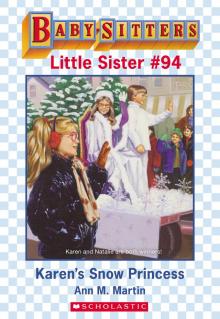 Karen's Snow Princess
Karen's Snow Princess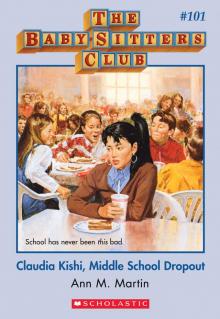 Claudia Kishi, Middle School Dropout
Claudia Kishi, Middle School Dropout Starring the Baby-Sitters Club!
Starring the Baby-Sitters Club! Kristy for President
Kristy for President California Girls!
California Girls! Maid Mary Anne
Maid Mary Anne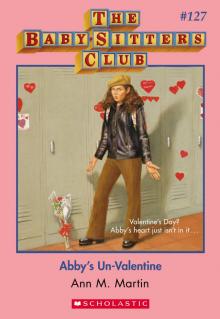 Abby's Un-Valentine
Abby's Un-Valentine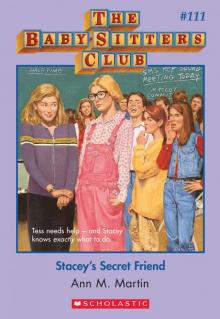 Stacey's Secret Friend
Stacey's Secret Friend Karen's Haunted House
Karen's Haunted House Claudia and Crazy Peaches
Claudia and Crazy Peaches Karen's Prize
Karen's Prize Get Well Soon, Mallory!
Get Well Soon, Mallory! Karen's Doll Hospital
Karen's Doll Hospital Karen's Newspaper
Karen's Newspaper Karen's Toothache
Karen's Toothache Mary Anne and Miss Priss
Mary Anne and Miss Priss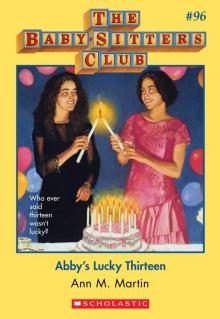 Abby's Lucky Thirteen
Abby's Lucky Thirteen The Secret Book Club
The Secret Book Club The All-New Mallory Pike
The All-New Mallory Pike Karen's Turkey Day
Karen's Turkey Day Karen's Magician
Karen's Magician Mary Anne and the Library Mystery
Mary Anne and the Library Mystery Diary One: Dawn, Sunny, Maggie, Amalia, and Ducky
Diary One: Dawn, Sunny, Maggie, Amalia, and Ducky Mary Anne and the Secret in the Attic
Mary Anne and the Secret in the Attic Kristy and the Mother's Day Surprise
Kristy and the Mother's Day Surprise Karen's in Love
Karen's in Love Welcome to the BSC, Abby
Welcome to the BSC, Abby Karen's Kittycat Club
Karen's Kittycat Club The Mystery at Claudia's House
The Mystery at Claudia's House The Truth About Stacey
The Truth About Stacey Karen's Bully
Karen's Bully Karen's Gift
Karen's Gift BSC in the USA
BSC in the USA Everything for a Dog
Everything for a Dog Dawn and the We Love Kids Club
Dawn and the We Love Kids Club Karen's Ghost
Karen's Ghost Stacey's Lie
Stacey's Lie Jessi's Secret Language
Jessi's Secret Language Kristy and the Missing Child
Kristy and the Missing Child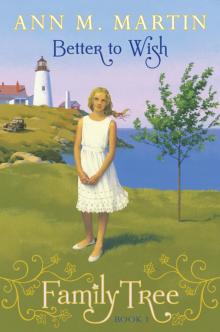 Better to Wish
Better to Wish Baby-Sitters on Board!
Baby-Sitters on Board! Kristy at Bat
Kristy at Bat Everything Changes
Everything Changes Don't Give Up, Mallory
Don't Give Up, Mallory A Dog's Life: The Autobiography of a Stray
A Dog's Life: The Autobiography of a Stray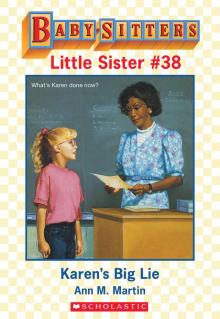 Karen's Big Lie
Karen's Big Lie Karen's Show and Share
Karen's Show and Share Mallory Hates Boys (and Gym)
Mallory Hates Boys (and Gym) Diary Two: Dawn, Sunny, Maggie, Amalia, and Ducky
Diary Two: Dawn, Sunny, Maggie, Amalia, and Ducky Karen's Pen Pal
Karen's Pen Pal Claudia and the Friendship Feud
Claudia and the Friendship Feud Karen's Secret Valentine
Karen's Secret Valentine Keep Out, Claudia!
Keep Out, Claudia! Aloha, Baby-Sitters!
Aloha, Baby-Sitters! Welcome Back, Stacey
Welcome Back, Stacey Jessi Ramsey, Pet-Sitter
Jessi Ramsey, Pet-Sitter Karen's Pizza Party
Karen's Pizza Party Kristy and the Dirty Diapers
Kristy and the Dirty Diapers Staying Together
Staying Together Dawn and the Surfer Ghost
Dawn and the Surfer Ghost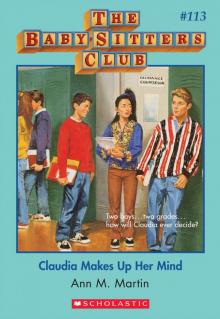 Claudia Makes Up Her Mind
Claudia Makes Up Her Mind Jessi's Gold Medal
Jessi's Gold Medal Karen's Kite
Karen's Kite Baby Animal Zoo
Baby Animal Zoo Dawn's Big Move
Dawn's Big Move Karen's Big Joke
Karen's Big Joke Karen's Lemonade Stand
Karen's Lemonade Stand Ma and Pa Dracula
Ma and Pa Dracula Baby-Sitters' Haunted House
Baby-Sitters' Haunted House Abby and the Mystery Baby
Abby and the Mystery Baby Home Is the Place
Home Is the Place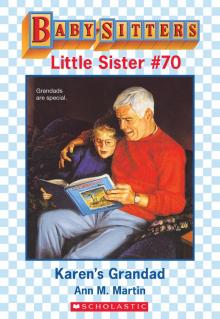 Karen's Grandad
Karen's Grandad Twin Trouble
Twin Trouble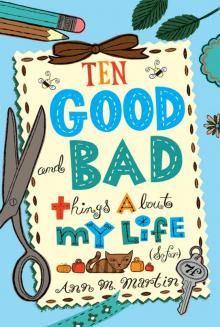 Ten Good and Bad Things About My Life (So Far)
Ten Good and Bad Things About My Life (So Far) Diary Two
Diary Two Baby-Sitters Club 027
Baby-Sitters Club 027 Claudia and the Mystery Painting
Claudia and the Mystery Painting Diary One
Diary One Baby-Sitters Club 037
Baby-Sitters Club 037 Baby-Sitters Club 028
Baby-Sitters Club 028 Baby-Sitters Club 085
Baby-Sitters Club 085 Dawn Schaffer Undercover Baby-Sitter
Dawn Schaffer Undercover Baby-Sitter Jessi's Babysitter
Jessi's Babysitter The Baby-Sitters Club #110: Abby the Bad Sport (Baby-Sitters Club, The)
The Baby-Sitters Club #110: Abby the Bad Sport (Baby-Sitters Club, The) Karen's Little Sister
Karen's Little Sister Baby-Sitters Club 058
Baby-Sitters Club 058 Claudia And The Genius On Elm St.
Claudia And The Genius On Elm St. Missy Piggle-Wiggle and the Sticky-Fingers Cure
Missy Piggle-Wiggle and the Sticky-Fingers Cure Kristy and Kidnapper
Kristy and Kidnapper Baby-Sitters Club 041
Baby-Sitters Club 041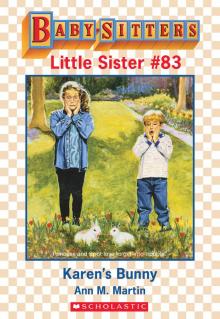 Karen's Bunny Trouble
Karen's Bunny Trouble Baby-Sitters Club 032
Baby-Sitters Club 032 Diary Three
Diary Three Christmas Chiller
Christmas Chiller Karen's Half-Birthday
Karen's Half-Birthday Needle and Thread
Needle and Thread Secret Life of Mary Anne Spier
Secret Life of Mary Anne Spier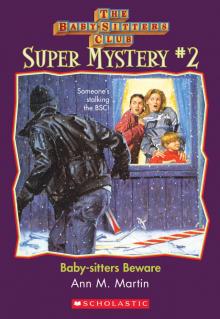 Baby-Sitters Beware
Baby-Sitters Beware Claudia Kishi, Middle School Drop-Out
Claudia Kishi, Middle School Drop-Out Logan Likes Mary Anne !
Logan Likes Mary Anne ! Baby-Sitters Club 061
Baby-Sitters Club 061 Best Friends
Best Friends Baby-Sitters Club 031
Baby-Sitters Club 031 Karen's Little Witch
Karen's Little Witch Jessi Ramsey, Petsitter
Jessi Ramsey, Petsitter Baby-Sitters Club 123
Baby-Sitters Club 123 Baby-Sitters Club 059
Baby-Sitters Club 059 Baby-Sitters Club 033
Baby-Sitters Club 033 Baby-Sitters Club 060
Baby-Sitters Club 060 Baby-Sitters Club 094
Baby-Sitters Club 094 The Baby-Sitters Club #99: Stacey's Broken Heart
The Baby-Sitters Club #99: Stacey's Broken Heart The Baby-Sitters Club #109: Mary Anne to the Rescue (Baby-Sitters Club, The)
The Baby-Sitters Club #109: Mary Anne to the Rescue (Baby-Sitters Club, The) Mystery At Claudia's House
Mystery At Claudia's House Claudia And The Sad Goodbye
Claudia And The Sad Goodbye Mary Anne's Big Break-Up
Mary Anne's Big Break-Up Baby-Sitters Club 025
Baby-Sitters Club 025 Baby-Sitters Club 042
Baby-Sitters Club 042 Stacey and the Mystery of the Empty House
Stacey and the Mystery of the Empty House Karen's Baby-Sitter
Karen's Baby-Sitter Claudia's Friendship Feud
Claudia's Friendship Feud Baby-Sitters Club 090
Baby-Sitters Club 090 Baby-Sitters Club 021
Baby-Sitters Club 021 Baby-Sitters Club 056
Baby-Sitters Club 056 Baby-Sitters Club 040
Baby-Sitters Club 040 The Baby-Sitters Club #108: Don't Give Up, Mallory (Baby-Sitters Club, The)
The Baby-Sitters Club #108: Don't Give Up, Mallory (Baby-Sitters Club, The) Dawn and the Impossible Three
Dawn and the Impossible Three The Snow War
The Snow War Special Delivery
Special Delivery Baby-Sitters Club 057
Baby-Sitters Club 057 Mary Anne And Too Many Babies
Mary Anne And Too Many Babies Baby-Sitters Club 030
Baby-Sitters Club 030